3D-printed portable toilet ‘The Throne’ offers a snazzier place to answer nature’s call
3D-printed from upcycled single-use medical plastic, ‘The Throne’ by To.org and Nagami reinvents the portable toilet and brings an ‘unsexy conversation’ about sanitation to the forefront
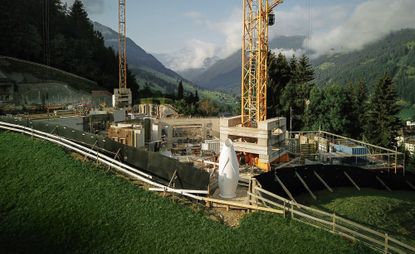
Portable toilets are unglamorous things. Often made from polyurethane, which is lightweight, easy to mould but notoriously difficult to recycle, they are designed for functionality rather than form, and one prefers to spend as little time in them as possible. Across the venues that require them – festivals, campsites and construction sites for example – they should ideally be concealed, lest they get in the way of work or pleasure.
The Throne: reinventing the portable toilet
A new portable toilet, installed amid the picturesque landscape of Gstaad in August 2021, aims to challenge this paradigm. Tagged ‘The Throne’, it has been commissioned by To.org – a foundation that creates, funds and cross-pollinates initiatives that address the world’s most pressing social and environmental challenges – and made by Nagami, a Spanish studio that specialises in computational design. Its streamlined form vaguely resembles a rocket (tapered at the top and bottom, bulging at the core and with a slightly truncated base), and importantly, the bulk of the design has been 3D-printed from discarded single-use plastics from medical facilities, sourced by a Dutch company called Reflow.

The Throne has an organic form, made possible by additive manufacturing, and an almond-shaped sliding door that helps keep its footprint to a minimum. Courtesy of To.org
‘It was last October when we broke ground here on a new project,’ says To.org co-founder and CEO Nachson Mimran of The Throne’s genesis. ‘As I arrived on the construction site, I needed the loo and walked into one of the portable toilets that we’re used to seeing in these types of places. I didn’t enjoy my few minutes in this cubicle, and came out wondering if we could do something different.’
To.org: from bottle brick to 3D-printing
To.org has worked extensively on the African continent, particularly in the impoverished neighbourhood of Kyebando in Kampala, Uganda. Through its Shadowman Van project, inspired by a Richard Hambleton artwork that Mimran had acquired at an Amfar auction (a 1977 Chevrolet ice cream truck, painted over by the artist and since transformed into a space for creative conversations), it installed replica, static ice cream vans with video conferencing equipment at these locations. The vans are connected with one another and with the original, which sits at The Alpina Gstaad, the hotel where Mimran serves as chairman and creative director (the Alpina won a Wallpaper* Design Award in 2013 for 'Best winter retreat').
A post shared by to.org (@to_creativeactivists)
A photo posted by on
A Shadowman Van, installed by To.org in the neighbourhood of Kyebando in Kampala, Uganda, enables dialogues between To.org’s creative activists in Uganda and the rest of the world
‘It was a way to have a dialogue remotely with our friends, using the vans as a hub to bring forward ideas and discuss the challenges they’re facing,’ Mimran explains. One of the realisations was that there was really no sanitation in Kyebando; so in 2018, To.org orchestrated the creation of a toilet building made from plastic bottles that had been stuffed with discarded polythene bags. The Bottle Brick Toilet, as it was called, wound up comprising 13,356 bottles and over a million bags, employing more than 400 people during its construction and offering a safe and private spot for locals to relieve themselves and attend to their menstrual needs.
By doing something in a more creative, and obviously upcycled way, we could get into popular culture both locally and internationally, and spark a wave of inspiration and imitation.
The hype surrounding the Bottle Brick Toilet enabled To.org to partner with a non-profit called GiveLove, to construct further sustainable and hygienic public toilets in Kyebando that could simultaneously address the challenges of human and plastic waste.
Wallpaper* Newsletter
Receive our daily digest of inspiration, escapism and design stories from around the world direct to your inbox
A post shared by to.org (@to_creativeactivists)
A photo posted by on
Completed in 2018, To.org's Bottle Brick Toilet in Kyebando comprises 13,356 bottles and over a million bags, and employed more than 400 people during its construction
The Throne shares the same ethos as these earlier toilets, though its sleek, futuristic design places it on the opposite end of the visual spectrum. One of the core goals of the new project was to explore additive manufacturing, which has the potential to revolutionise construction especially in developing countries. Mimran and Nagami’s CEO, Manuel Jimenez García, bonded over their shared interest in this technology at a London event in 2019 and have been bouncing around ideas since, including for a 3D-printed pavilion, inspired by igloos, that could serve a similar function to the Shadowman Vans. Alongside, it made sense to work on a portable toilet so the pavilion could be placed in remote locations that lack sanitary facilities.
RELATED STORY
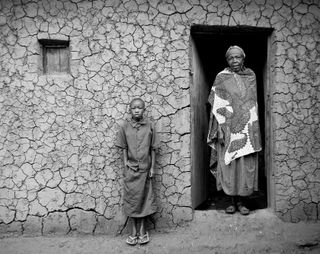
Designing The Throne
The shape of The Throne nods to the similarly organic, clamshell-like form of the pavilion, currently a work in progress. The choice of colour, a brilliant white, serves to align their aesthetics, the widened core of The Throne gives the user more space to move around, while an almond-shaped sliding door helps keep its physical footprint to a minimum and adds a sense of ceremony to entering and exiting. A skylight enables natural illumination and, in fine weather, offers a vertical view to brighten one’s day. Inside, an inbuilt shelf allows storage of toilet paper and a place for the user to put down their phone, while separate containers for solid and liquid waste facilitate eventual composting. An additional container accommodates wood chips to eliminate undesirable smells.
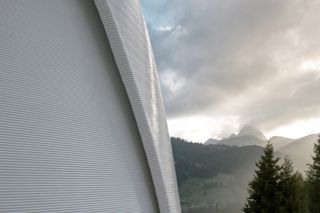
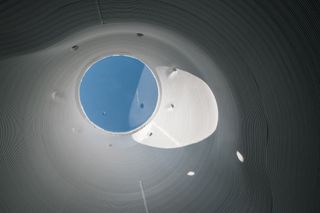
Top: a detail of the 3D-printed Throne, which is designed in brilliant white, to match the igloo-inspired 3D-printed pavilion it will eventually accompany. Above: The Throne features a skylight for natural illumination and vertical viewing. Courtesy of To.org
Using a seven-axis robotic 3D printer produced by ABB, Nagami was able to print the main components of The Throne in three days (the body, door, and a bucket for solid waste; the base and some smaller accessories were either injection-moulded or ordered). A rapid turnaround for sure, though Mimran admits that there is some way to go before a similar Throne can be produced in Uganda. While To.org, alongside local NGO You & I Foundation, runs a fab lab in Kyebando that has an advanced 3D printer, Nagami’s printer has greater energy and maintenance requirements and requires more extensive training for a bigger team. There are other design challenges – unlike traditional portable toilets, The Throne is not stackable, which makes it more difficult to scale.
The Throne currently exists as an edition of one, but rather than treating it as a display piece, Mimran has put it to work on the same construction site where he had come up with the idea for its creation, and made it accessible to everyone. ‘A public toilet is a public toilet. If our team at the construction site enjoy this moment, as much as I enjoyed testing it, they would probably be in a better mood to perform the work that they do.’ He is thrilled with the response so far, both from leading architects and designers whom he recently hosted in Gstaad for a creative workshop, and from local kids whom he’s seen ‘running up and down the hill to pay their respects to this foreign looking object at the top’.


Top: a detail of the toilet, which includes separate containers for solid and liquid human waste to facilitate eventual compositing. Above: To.org co-founder and CEO Nachson Mimran inside The Throne. Courtesy of To.org
Creative activism and the future of manufacturing
Mimran would like The Throne to serve as a provocation: it brings an ‘unsexy conversation’ about sanitation to the forefront, and also encourages mass additive manufacturing providers to accelerate The Throne’s path to existence in more remote places. He adds, ‘We believe that this technology needs to go through the same kind of processes as photovoltaics went through – it used to be a luxury to harness the sun for its energy, and now it’s probably one of the cheapest sources.’
Hopefully, we will be able to bring together a coalition to drive down the costs of distributed digital manufacturing, so it’s not only in the hands of privileged creatives and designers, but also with those who are designing essential and vital objects for their survival.
Nagami’s Jímenez Garcia concurs: ‘We hope that this exercise of rethinking an incredibly banal object such as a portable toilet will inspire a new generation of designers and makers to really erase every preconception of what an object should be.’
To.org co-founder and CEO Nachson Mimran, and Nagami CEO Manuel Jimenez García explain the story behind The Throne. Video courtesy of To.org
INFORMATION
TF Chan is a former editor of Wallpaper* (2020-23), where he was responsible for the monthly print magazine, planning, commissioning, editing and writing long-lead content across all pillars. He also played a leading role in multi-channel editorial franchises, such as Wallpaper’s annual Design Awards, Guest Editor takeovers and Next Generation series. He aims to create world-class, visually-driven content while championing diversity, international representation and social impact. TF joined Wallpaper* as an intern in January 2013, and served as its commissioning editor from 2017-20, winning a 30 under 30 New Talent Award from the Professional Publishers’ Association. Born and raised in Hong Kong, he holds an undergraduate degree in history from Princeton University.
-
 Frank Stephenson’s high-flying capsule design for HALO’s balloon-powered space flights
Frank Stephenson’s high-flying capsule design for HALO’s balloon-powered space flightsSpace start-up HALO promises zero-emission travel to the stratosphere in a futuristic viewing capsule shaped by Frank Stephenson Design
By Jonathan Bell Published
-
 Back to Black: all eyes on film-maker Sam Taylor-Johnson
Back to Black: all eyes on film-maker Sam Taylor-JohnsonBack to Black cinematographer Polly Morgan tells Wallpaper* how a shared love of French New Wave close-ups brought Sam Taylor-Johnson’s Amy Winehouse biopic to life
By Craig McLean Published
-
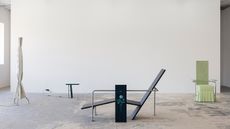 Formafantasma’s new collection explores nostalgia and the queer identity
Formafantasma’s new collection explores nostalgia and the queer identityFormafantasma present 'La Casa Dentro' at Fondazione ICA Milano (until 19 July 2024), where they draw inspiration from the domestic sphere and their own nostalgic perceptions of home
By Laura May Todd Published
-
 Hyperlocal design: these Atelier100 products are made within 100km of London
Hyperlocal design: these Atelier100 products are made within 100km of LondonAtelier100 launches its retail space and debut locally focused design collection in London’s Hammersmith
By Martha Elliott Published
-
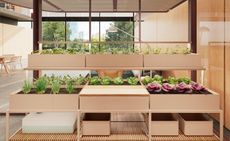 Kettal and Tectum’s indoor hydroponic garden combats cabin fever with office-grown veg
Kettal and Tectum’s indoor hydroponic garden combats cabin fever with office-grown vegKettal and Tectum Garden’s hydroponic indoor garden offers new opportunities for home-grown veg and adds a sprinkle of greenery to office spaces
By Martha Elliott Last updated
-
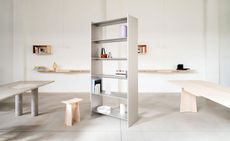 Formafantasma’s minimalist, responsible shelving system for Hem
Formafantasma’s minimalist, responsible shelving system for HemFormafantasma and Hem unveil the ‘T Shelf’, a design in extruded aluminium created in collaboration with specialist Hydro
By Anne Soward Last updated
-
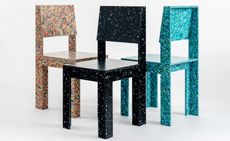 Post consumer waste design: Jane Atfield’s groundbreaking recycled chair turns 30
Post consumer waste design: Jane Atfield’s groundbreaking recycled chair turns 30New York gallerist Emma Scully revisits the groundbreaking design of Jane Atfield's RCP2 recycled plastic chair, on the 30th anniversary of its creation
By Pei-Ru Keh Last updated
-
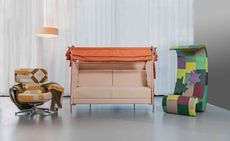 Glasgow School of Art students give new life to CitizenM lobby furniture
Glasgow School of Art students give new life to CitizenM lobby furnitureCoinciding with COP26, CitizenM partners with The Glasgow School of Art to showcase iconic Vitra furniture pieces repurposed by interior design students in collaboration with Bute Fabrics
By Rosa Bertoli Last updated
-
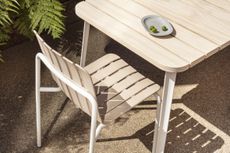 Very Good & Proper’s new sustainable outdoor furniture is summer-ready
Very Good & Proper’s new sustainable outdoor furniture is summer-readyNew all-weather furniture by Very Good & Proper combines sustainable materials with a minimal design, suitable for any outdoor space, from leafy gardens to urban balconies
By Rosa Bertoli Last updated
-
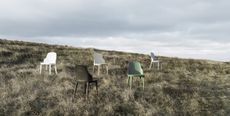 Sustainable furniture: responsible chairs made from recycled materials
Sustainable furniture: responsible chairs made from recycled materialsDesigners such as Tom Dixon, Nendo and Konstantin Grcic have upped their sustainability efforts, with ongoing R&D resulting in sustainable furniture collections, including garden furniture, that merge good design with a responsible approach
By Rosa Bertoli Last updated
-
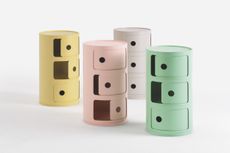 Kartell’s industrial manifesto puts sustainability front and centre
Kartell’s industrial manifesto puts sustainability front and centreKartell presents its sustainability manifesto, revisiting classic products like the ‘Componibili’ cabinet in biodegradable materials, and introducing new sustainable designs in recycled plastics by Philippe Starck and Antonio Citterio
By Rosa Bertoli Published